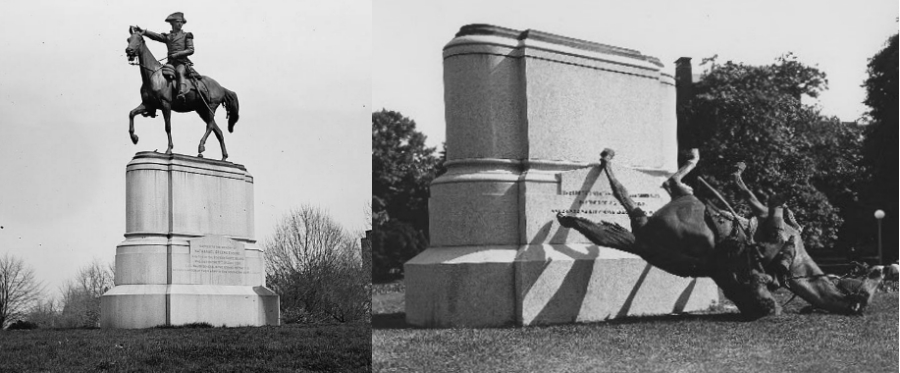 In this quiet week between Christmas and the New Year, I have decided to repost one of my favorite stories from the past year, in which I looked into the story wherein the Nathanael Greene statue in Stanton Park had fallen off its pedestal once, long ago. It is one of those stories that sound almost too good to be true. Well, as it turns out, it actually happened and the collective memory of the neighborhood remembers it correctly to this day.
In this quiet week between Christmas and the New Year, I have decided to repost one of my favorite stories from the past year, in which I looked into the story wherein the Nathanael Greene statue in Stanton Park had fallen off its pedestal once, long ago. It is one of those stories that sound almost too good to be true. Well, as it turns out, it actually happened and the collective memory of the neighborhood remembers it correctly to this day.
1930 was a pretty warm year, and June 6 was no exception, with the thermometer reaching into the mid-80s at 3:00 PM. Not exactly brutal, but not refreshing, either. Nonetheless, it was too much for at least some things in D.C.: a set of bolts integral in keeping the equestrian statue of Nathanael Greene anchored to his pedestal, for one.
When the Greene statue had been erected in 1877, just six bolts were used to anchor it to its pedestal: three in its front left hoof, three in the back right. (The other two hooves are in the air, and no, Greene was never injured in battle.) Over the years, two of the bolts in the rear hoof had sheared off, presumably due to the normal freeze/thaw cycle, and about 3:00 PM, the other four followed suit, which precipitated horse and rider off the top of the pedestal, tip over, and fall to the ground. Green’s entire head was buried in the soft ground next to the pedestal, all the way to the shoulders. One hoof came to rest on the side of the pedestal but without, apparently, injuring it.
The Washington Post reported the following day that the men from the National Capital Park and Planning Commission “found the general’s noble brow inextricably buried in the soil, and, indeed, his chin and shoulders, but, although they have not yet made their official report, it was apparent that the only actual damage done was to the greensward, and the only monetary loss involved is that of the labor of hoisting the general back up on his perch and replacing the six shattered brass bolts.”
The replacement was done almost immediately, and, in fact Col U. S. Grant 3d, grandson of the former president, then the director of the Public Parks and Public Buildings in Washington, ordered that all other statues under his purview should be inspected for similar issues.
As it turned out, all but one of the statues were in fine shape. The one requiring attention was that of General John A. Logan in his eponymous circle. Logan’s statue was thus removed early in 1931 in order to, as the Post put it, “strengthen the fastenings.” The whole operation was over in a couple of weeks, and, since then, all statues in D.C. have remained exactly where they were supposed to.
In fact, it seems that most of the statues that have toppled since then were done on purpose, as part of the general upheaval in the Eastern Bloc and Middle East in the 1990s and early 2000s. On June 6, 1930, however, it happened all by itself and straight into the collective memory of the Stanton Park neighborhood.

